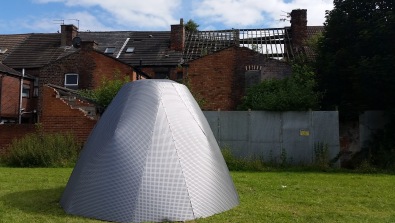Until 16th October, various locations around L8, free.
Toxteth Reservoir is only open Saturdays & Sundays, all other works are in situ for the duration.
One aspect of art that a casual observer may not always consider is that some artworks are completed by their placement. Sometimes art is just about the form of the object, but often an artist wants to make a statement which can only be completely understood in a certain place or time. The history of this can be traced back for at least 100 years to Malevich and Duchamp, and I could spend a whole post giving examples.
For the past 6 years I’ve driven on the main roads of L8, thinking only in passing about the streets stretching off to the sides. As a non-native of Liverpool I’ve heard the history of the area, I know about the Pathfinder fiasco, about the revival around the Four Streets. But it’s only the Biennial that’s given me a motivation to go and explore the area. It’s an area which clearly has a story to tell, and which each artwork I encounter on my way helps you explore.
 My first stop is Toxteth Reservoir. If you’ve ever driven up High Park Street (behind the Tesco) and noticed an imperious wall, well, this is the space it hides. A monument to Victorian Liverpool’s efforts to keep the city’s working population healthy. Having stood empty for almost 20 years, for the next 3 months it is home to a work by Rita McBride which is described as an “opening between real and fictional worlds” in the guidebook. Th beams of light intersecting their way across the huge space are certainly beautiful. I almost reach out to touch it but it’s too distant and, anyway, not really physical. The border between fiction and reality is indeed thin here.
My first stop is Toxteth Reservoir. If you’ve ever driven up High Park Street (behind the Tesco) and noticed an imperious wall, well, this is the space it hides. A monument to Victorian Liverpool’s efforts to keep the city’s working population healthy. Having stood empty for almost 20 years, for the next 3 months it is home to a work by Rita McBride which is described as an “opening between real and fictional worlds” in the guidebook. Th beams of light intersecting their way across the huge space are certainly beautiful. I almost reach out to touch it but it’s too distant and, anyway, not really physical. The border between fiction and reality is indeed thin here.
I head back out into the sunlight and continue up High Park Street towards the Welsh Streets and Lara Favaretto’s installation Momentary Monument – The Stone, 2016. Judging from my Instagram feed this has already become one of the icons of the show, and it is easy to see why. Standing right in the middle of an otherwise abandoned street, it reminds me of the monolith from 2001: A Space Odyssey. How did it get there? What it is for?
The word “momentary” in the title is key. At the end of the Biennial this stone will be demolished. You will notice a slot on the stone, this is for passers-by to deposit coins into, with all donations ultimately being donated to Asylum Link Merseyside.
This monument not only looks imposing in its own right, but gives and takes meaning from its surrounding. These boarded up houses now act as their own symbols of something which used to exist, but has now been lost. With its destruction, though, the stone will provide some benefit to humanity. Can the same be said about these streets?
The answer to that may lie on the other side of Princes Road.
On this sunny(ish) Friday afternoon, Granby Street is a colourful, multicultural corner of the city, and has a nice feeling to it. The first artwork I find is an example of how the area is being revived. The Granby Workshop is a community workshop making objects for the home, and a tile design decorates the outside of their workshop space, a symbol of the area’s creative regeneration.
So busy am I thinking about the workshop and this place that I completely miss the neighbouring Last Planet Parade.

Alisa Baremboym’s Locus of Control bringing attention to the local “survival and displacement”.
My last stop is Alisa Baremboym’s Locus of Control, and it’s the piece which I find most disappointing. It sounds so promising in the guidebook, exploring the tension “between the body and its environment“, but I don’t find much meaning in its shape, or from gazing through the holes to the inner forms. Reflecting on this later, however, it occurs to me that maybe this is because the surrounding area tells its own story about “survival and displacement“. Looking at it from one angle the sculpture is backed by decaying, closed houses – but from another, a busy market in the Mosque courtyard. You could spend your time appraising the sculpture on its own merits or by contemplating it in relation to the area, which I strongly felt gives it more meaning.
Throughout my walk I repeatedly came to the artworks at the same time as a minibus tour. I am sure that for visitors this option seems to make sense, as you never quite know how far it is to walk to places in new cities. But I would thoroughly recommend walking to get a real sense of the place and what these artworks are really saying.

2 thoughts on “Liverpool Biennial Edition 1: A walk in the suburbs”